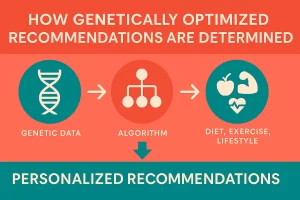How a Personalized Genetic Scoring System Is Derived
In the evolving landscape of health and fitness, the integration of genetic data into personalized exercise and nutrition plans is increasingly prevalent. Understanding how a Personalized Genetic Scoring System (PGSS) is derived is essential for fitness professionals aiming to offer tailored recommendations to their clients. This article explores the methodologies behind PGSS, emphasizing the role of algorithms in assessing the net effect of multiple genes, and highlighting the importance of considering genetic advice within the broader context of other genetic factors, demographic variables, and lifestyle choices.
Understanding Genetic Variants and Their Influence
Genetic variants, particularly single nucleotide polymorphisms (SNPs), play a significant role in determining individual responses to diet and exercise. For instance, variations in genes related to metabolism, muscle composition, and nutrient absorption can influence how a person responds to specific dietary components or physical activities. However, it’s crucial to recognize that these effects are not solely dependent on a single genetic variant but result from complex interactions among multiple genes, environmental factors, and lifestyle choices.
Collecting and Analyzing Genetic Data
The first step in developing a PGSS involves collecting an individual’s genetic data, typically through direct-to-consumer genetic testing services. Once obtained, this data undergoes rigorous analysis to identify relevant SNPs associated with fitness and nutritional outcomes. The selection of these SNPs is grounded in robust scientific research that establishes clear links between specific genetic variations and physiological responses.
Assigning Weights to Genetic Variants

How a Personalized Genetic Scoring System Is Derived
Not all genetic variants exert the same influence on health outcomes. Therefore, each identified SNP is assigned a weight reflecting its relative impact. This weighting process considers factors such as the strength of the association established in scientific literature, the magnitude of the effect, and the consistency of findings across diverse populations. By assigning appropriate weights, the system ensures that more influential genes have a greater impact on the final score.
Calculating Polygenic Scores
With weighted SNPs identified, the next step is to calculate polygenic scores for various traits, such as predisposition to obesity, response to specific nutrients, or potential for muscle growth. These scores are derived by summing the weighted effects of relevant SNPs, providing a cumulative assessment of genetic predispositions. It’s important to note that these scores represent probabilities, not certainties, and should be interpreted within the broader context of an individual’s overall health profile.
Integrating Environmental and Lifestyle Factors
Genetics is just one piece of the puzzle. Environmental and lifestyle factors, including diet, physical activity, sleep patterns, and stress levels, significantly influence health outcomes. A comprehensive PGSS integrates these variables to provide a holistic view of an individual’s health. This integration ensures that recommendations are not solely based on genetic predispositions but also account for modifiable factors that can be adjusted to optimize health.
Developing Personalized Recommendations
Armed with polygenic scores and comprehensive lifestyle data, algorithms generate personalized exercise and nutrition recommendations. These algorithms assess the net effect of multiple genes and their interactions with environmental factors to tailor advice that aligns with an individual’s unique genetic makeup and lifestyle. For example, someone with a genetic predisposition to higher carbohydrate sensitivity may receive guidance to moderate their carbohydrate intake, coupled with exercise recommendations that enhance insulin sensitivity.
Continuous Monitoring and Adaptation
Health is dynamic, and as such, personalized recommendations should be adaptable. Continuous monitoring of an individual’s progress allows for adjustments to be made to exercise and nutrition plans. This iterative process ensures that interventions remain effective and responsive to changes in health status, goals, and emerging scientific insights.
Ethical Considerations and Data Privacy
Utilizing genetic data in personalized health interventions raises important ethical and privacy considerations. It’s imperative to ensure that individuals provide informed consent and that their genetic information is handled with the utmost confidentiality. Transparency in how data is used and the limitations of genetic information in predicting health outcomes is crucial to maintain trust and integrity in personalized health services.
Conclusion: How a Personalized Genetic Scoring System is Derived
Deriving a Personalized Genetic Scoring System involves a meticulous process of collecting and analyzing genetic data, assigning appropriate weights to genetic variants, integrating environmental and lifestyle factors, and developing tailored recommendations through sophisticated algorithms. For fitness professionals, understanding this process is vital to effectively incorporate genetic insights into personalized exercise and nutrition plans. However, it’s essential to remember that genetic predispositions are just one aspect of an individual’s health profile. A holistic approach that considers the interplay of genes, environment, and lifestyle is paramount in crafting effective and sustainable health interventions.
References
- Corella, D., & Ordovás, J. M. (2022). The role of nutrition in the prevention of common diseases: Impact of gene-diet interactions. Public Health Nutrition, 25(1), 1–9. https://www.cambridge.org/core/journals/public-health-nutrition/article/role-of-nutrition-in-the-prevention-of-common-diseases-impact-of-genediet-interactions/4D0C0D1F019BACD74FCFF60771229102
- Elinav, E. (2023). Eran Elinav. Wikipedia. https://en.wikipedia.org/wiki/Eran_Elinav
- Livingstone, K. M., Celis-Morales, C., & Lovegrove, J. A. (2022). Nutrigenomics and Personalized Diets: What Do We Know Today? Current Nutrition Reports, 11, 187–196. https://link.springer.com/article/10.1007/s13668-022-00418-w
- Merino, J., Guasch-Ferré, M., Li, J., et al. (2022). Polygenic scores, diet quality, and type 2 diabetes risk. PLOS Medicine. https://pmc.ncbi.nlm.nih.gov/articles/PMC9041832/
- Ordovas, J. M., Ferguson, L. R., Tai, E. S., & Mathers, J. C. (2023). Personalized nutrition and health. BMJ, 379, e071302. https://www.bmj.com/content/379/bmj-2022-071302
- Phillips, C. M. (2022). Nutrigenetics and metabolic disease: Current status and implications for personalized nutrition. Nutrients, 14(2), 278. https://www.mdpi.com/2072-6643/14/2/278
- Sharma, S., et al. (2022). Data in Personalized Nutrition: Bridging Biomedical, Psycho-Behavioral, and Environmental Aspects. Journal of the Academy of Nutrition and Dietetics. https://www.sciencedirect.com/science/article/abs/pii/S2212267222011571
- Shyam, S., Lee, K. X., Tan, A. S. W., et al. (2022). Effect of Personalized Nutrition on Dietary, Physical Activity, and Health Outcomes: A Systematic Review of Randomized Trials. Nutrients, 14(19), 4104. https://www.mdpi.com/2072-6643/14/19/4104
- Wang, F., et al. (2022). Personalized nutrition: A review of genotype-based nutritional supplementation. Frontiers in Nutrition. https://www.frontiersin.org/journals/nutrition/articles/10.3389/fnut.2022.992986/full
- Zeisel, S. H. (2023). Precision (Personalized) Nutrition: Progress and Challenges. Annual Review of Food Science and Technology, 14, 151-172. https://www.annualreviews.org/doi/full/10.1146/annurev-food-053021-091125
